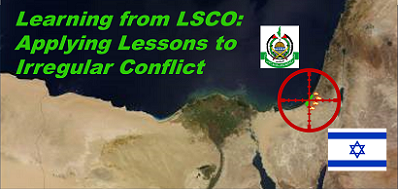[Editor’s Note: Two years ago, Army Mad Scientist featured a podcast and associated blog post with Dr. Brent L. Sterling, Adjunct Professor at Georgetown University’s Edmund A. Walsh School of Foreign Service and author of Other People’s Wars: The US Military and the Challenge of Learning from Foreign Conflicts, discussing how militaries learn (or don’t!) from foreign conflicts, what pitfalls await those trying to learn from historical conflicts, how focusing only on “relevant” observations hampers our creativity in analyzing warfare, and what strategists can do to avoid past mistakes.
Since then, Russia invaded and continues to wage Large-Scale Combat Operations (LSCO) in Ukraine. Our pacing challenge, China, is observing, learning, and tailoring its People’s Liberation Army accordingly — check out the TRADOC G-2’s China Landing Zone and review the thirty-plus snapshots captured to date addressing what China is learning from Russia’s war against Ukraine and the implications for the U.S. Army and the Joint Force (note that a DoD Common Access Card [CAC] is required to access this information).
But others are learning and adapting, too! Less than two weeks ago, HAMAS launched its massed surprise attack on Israel across multiple domains. Army Mad Scientist welcomes returning authors Ian Sullivan and Kate Kilgore with today’s timely post exploring the contemporary LSCO lessons HAMAS has learned and applied to the irregular conflict battlespace — Read on!]
HAMAS’s October 7th attacks on Israel demonstrate that the ability to conduct coordinated, massed operations in multiple domains is no longer the sole purview of nations with sophisticated militaries. HAMAS leveraged large volumes of fires to enable its invasion of Israeli territory and the deadliest attacks on Israel ever committed. The attack, and Israel’s response, could also propagate hybrid threats from surrounding countries and other violent extremist organizations (VEOs) and may even develop into a conflict on multiple fronts. The initial stages of the Israel-HAMAS conflict indicate that many Operational Environment factors previously thought inherent to large-scale combat operations between nation-states may be increasingly present in irregular conflicts.
Elements of Surprise: Deception, Operational Security, and Proximity
Limited indications and warnings (I&W) can allow an adversary with fewer net resources and capabilities to gain short-term advantage. HAMAS employed multiple deception and operational security measures in the planning phase and quickly capitalized on opportunities presented by other regional events to deny Israel’s sophisticated intelligence apparatus’s ability to detect the impending attack. In addition to exercising operational security measures limiting the use of electronic communications, HAMAS leaders likely waited to  give fighters any orders until a few hours before the operation.[i] The Gaza Strip’s proximity to Israel—where border fences are often within walking distance from Palestinian houses—and use of bulldozers, which are commonly present near border areas, also provided HAMAS the ability to obfuscate detection and move rapidly.[ii] The Israel Defense Forces (IDF) response to the attacks on October 7th were initially slow, as many IDF troops previously stationed near Gaza had been redeployed to border areas near the West Bank in response to rising tensions in previous weeks.[iii] It took several hours for the IDF to respond to the initial attacks and over two days of fighting to push HAMAS militants out of Israeli territory.[iv]
give fighters any orders until a few hours before the operation.[i] The Gaza Strip’s proximity to Israel—where border fences are often within walking distance from Palestinian houses—and use of bulldozers, which are commonly present near border areas, also provided HAMAS the ability to obfuscate detection and move rapidly.[ii] The Israel Defense Forces (IDF) response to the attacks on October 7th were initially slow, as many IDF troops previously stationed near Gaza had been redeployed to border areas near the West Bank in response to rising tensions in previous weeks.[iii] It took several hours for the IDF to respond to the initial attacks and over two days of fighting to push HAMAS militants out of Israeli territory.[iv]
Massed Effects Across Multiple Domains Overwhelm Defenses and Countermeasures
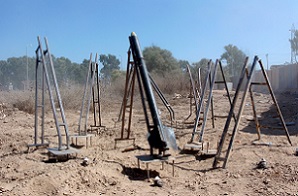
Advantages in time and space also allowed HAMAS to exploit an opportunity to overwhelm Israel’s defenses and countermeasures by massing effects across multiple domains. Prior to the wave of rockets which enabled the infiltration of Israeli territory, HAMAS used large numbers of commercial unmanned aerial vehicles (UAVs) to systematically drop small bombs on Israeli observation points, communication towers, security cameras, and weapons systems along Israeli border fortifications.[v] Then, over a period of 70 minutes, HAMAS launched more than 3,000 Qassam rockets—built from industrial piping, do-it-yourself rocket fuel comprising sugar and potassium nitrate fertilizer, and commercial explosives that can be quickly launched by a small number of militants—and military-grade battlefield rockets into Israeli air space from positions on land and in the Mediterranean.[vi] Although many of the rockets were intercepted, they were launched in a higher concentration than Israel’s Iron Dome air defense system previously faced at one time.[vii] These saturation salvos overwhelmed the Iron Dome’s ability to engage and interdict all of the rockets. Many Israeli air defense batteries expended their available missiles and were forced to reload, creating gaps in air defense coverage that was exploited by HAMAS 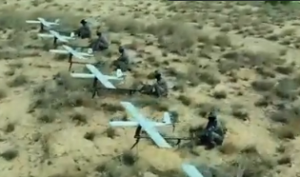 fighters to breach Israel’s defensive fortifications.[viii] Videos of the attacks posted to social media by HAMAS also show Al-Zawari one-way attack (OWA) UAVs launched simultaneously with the rocket barrages, creating complex dilemmas for Israeli defenses, while others show UAVs being employed for top-attack to drop anti-tank munitions on Israeli Merkava Mk 4 main battle tanks.[ix] In the days since the initial attacks, HAMAS has continued to launch UAVs and indirect fires at targets in southern Israel.[x]
fighters to breach Israel’s defensive fortifications.[viii] Videos of the attacks posted to social media by HAMAS also show Al-Zawari one-way attack (OWA) UAVs launched simultaneously with the rocket barrages, creating complex dilemmas for Israeli defenses, while others show UAVs being employed for top-attack to drop anti-tank munitions on Israeli Merkava Mk 4 main battle tanks.[ix] In the days since the initial attacks, HAMAS has continued to launch UAVs and indirect fires at targets in southern Israel.[x]
Harnessing Multiple Domains to Amplify Kinetic Effects
 HAMAS has also employed cyber and electronic warfare capabilities to enable its attacks, indicating that VEOs can increasingly access and leverage multiple domain capabilities to amplify kinetic effects and foment fear. In early 2023, the Gaza Strip based hacking group Storm-113 used fake LinkedIn profiles to send malware to employees of Israeli energy, defense, and telecommunications companies, allowing them to establish backdoor access to networks.[xi] Additionally, multiple hacktivist groups launched DDoS attacks that took Israeli government websites temporarily offline.[xii] Pro-Palestinian hackers also attacked the Israeli app designed to alert citizens of rocket strikes, sending fake notifications designed to look like legitimate military alerts reporting a nuclear weapon had been launched at Israel.[xiii] During the rocket
HAMAS has also employed cyber and electronic warfare capabilities to enable its attacks, indicating that VEOs can increasingly access and leverage multiple domain capabilities to amplify kinetic effects and foment fear. In early 2023, the Gaza Strip based hacking group Storm-113 used fake LinkedIn profiles to send malware to employees of Israeli energy, defense, and telecommunications companies, allowing them to establish backdoor access to networks.[xi] Additionally, multiple hacktivist groups launched DDoS attacks that took Israeli government websites temporarily offline.[xii] Pro-Palestinian hackers also attacked the Israeli app designed to alert citizens of rocket strikes, sending fake notifications designed to look like legitimate military alerts reporting a nuclear weapon had been launched at Israel.[xiii] During the rocket  strikes and efforts to breach Israel’s border defenses, HAMAS operatives jammed IDF communications networks at its headquarters in southern Gaza.[xiv] Since October 7th, many international hacktivist groups—some of which are allegedly connected to Russia—claim they have launched cyberattacks targeting Israeli energy infrastructure and missile alert systems.[xv] HAMAS used commercial UAVs to record their rocket and ground attacks and footage of violence, kidnappings, and killings, which they posted to Telegram. Users quickly spread the content to various other social media platforms, maximizing the impact of HAMAS’s terror campaign.[xvi] Conversely, these videos—in addition to those recorded by victims or collected by Israel’s vast network of surveillance cameras along its border recorded facial data of HAMAS fighters involved in the attacks—will enable Israel to identify, locate, and target them in the coming weeks.[xvii]
strikes and efforts to breach Israel’s border defenses, HAMAS operatives jammed IDF communications networks at its headquarters in southern Gaza.[xiv] Since October 7th, many international hacktivist groups—some of which are allegedly connected to Russia—claim they have launched cyberattacks targeting Israeli energy infrastructure and missile alert systems.[xv] HAMAS used commercial UAVs to record their rocket and ground attacks and footage of violence, kidnappings, and killings, which they posted to Telegram. Users quickly spread the content to various other social media platforms, maximizing the impact of HAMAS’s terror campaign.[xvi] Conversely, these videos—in addition to those recorded by victims or collected by Israel’s vast network of surveillance cameras along its border recorded facial data of HAMAS fighters involved in the attacks—will enable Israel to identify, locate, and target them in the coming weeks.[xvii]
Increased Lethality of Irregular Conflict in Urban Areas
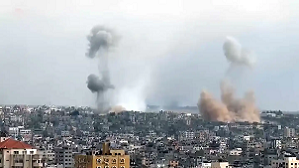
The fighting, concentrated in an area with numerous Israeli kibbutzes and villages and the densely populated Gaza Strip, also suggests that conflicts with irregular forces may be increasingly lethal. Surprise and opportunity enabled a few hundred HAMAS operatives to conduct the deadliest attack in Israel’s history, leaving more than 1,300—most of whom were civilians—killed.[xviii] In the days since the initial attack, Israel has conducted air strikes and bombings on reported HAMAS operating locations in Gaza, where the population density is estimated at over 21,000 people per square mile and targets are often located in close proximity to 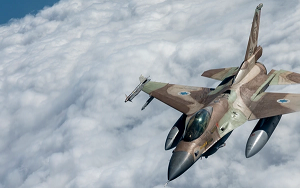 other structures.[xix] The Israel Air Force estimates they dropped 6,000 bombs on Gaza—equivalent to the total number of air strikes during the 50-day Israel-Gaza conflict in 2014—between October 7th and 12th alone.[xx] Simultaneously, concern over whether militants in the West Bank may act against Israel is increasing. On October 11th, the Israeli government issued the largest compulsory mobilization since the 1973 Yom Kippur War, calling up 360,000 reservists[xxi]—some of whom were living or vacationing overseas—to re-establish territorial security.[xxii]
other structures.[xix] The Israel Air Force estimates they dropped 6,000 bombs on Gaza—equivalent to the total number of air strikes during the 50-day Israel-Gaza conflict in 2014—between October 7th and 12th alone.[xx] Simultaneously, concern over whether militants in the West Bank may act against Israel is increasing. On October 11th, the Israeli government issued the largest compulsory mobilization since the 1973 Yom Kippur War, calling up 360,000 reservists[xxi]—some of whom were living or vacationing overseas—to re-establish territorial security.[xxii]
Competing for Narrative Advantage
 As both sides work to establish narrative advantage, ubiquitous information and misinformation have played a very large role in the conflict. Since the attack, social media and traditional news sites are flooded with content which runs the gambit between truth and falsehood, generated by both combatants and third parties.[xxiii] During the attacks, both HAMAS-linked profiles and Israeli victims posted graphic depictions of violence online in granular detail.[xxiv] In the wake of Israel’s retaliatory strikes and declaration of war on HAMAS, years-old photos and videos taken from past conflicts in different countries have been reported as footage from the current conflict.[xxv] Accusations of false news or mischaracterization are found on hundreds
As both sides work to establish narrative advantage, ubiquitous information and misinformation have played a very large role in the conflict. Since the attack, social media and traditional news sites are flooded with content which runs the gambit between truth and falsehood, generated by both combatants and third parties.[xxiii] During the attacks, both HAMAS-linked profiles and Israeli victims posted graphic depictions of violence online in granular detail.[xxiv] In the wake of Israel’s retaliatory strikes and declaration of war on HAMAS, years-old photos and videos taken from past conflicts in different countries have been reported as footage from the current conflict.[xxv] Accusations of false news or mischaracterization are found on hundreds  of Pro-Israel and Pro-Palestine posts alike—regardless of whether posts are truly misinformation—contributing to ideological division in the information space and diverging perceptions of truth.[xxvi] A large share of the information circulating about the conflict does not come from the combatants or the populations of Israel and Palestine, but from individuals and organizations outside of the region entirely.[xxvii]
of Pro-Israel and Pro-Palestine posts alike—regardless of whether posts are truly misinformation—contributing to ideological division in the information space and diverging perceptions of truth.[xxvi] A large share of the information circulating about the conflict does not come from the combatants or the populations of Israel and Palestine, but from individuals and organizations outside of the region entirely.[xxvii]
Tension between Escalation and Blowback

As the IDF prepares to deploy thousands of troops into Gaza, it could find itself in a fight where the demands of operating in densely populated terrain could further provide its adversaries with narrative ammunition to chip away at regional stability and Israel’s international support. Israeli air strikes and blockade measures—designed to drive HAMAS militants out from hiding by cutting off water, power, and food supplies in the Gaza Strip—have already drawn international criticism.[xxviii] Escalating operations could encourage militants located in the West Bank, who were already incensed regarding expanding Israeli settlements in the region, to open a second front in the Israel-HAMAS war.[xxix] Hizballah began shelling the border between Israel and Lebanon, and many other VEOs in the region have expressed support for HAMAS.[xxx] While Iran denies having any role in the recent attacks, Tehran has expressed support for the operation and has long politically and financially supported HAMAS. For over a year, Iran provided military training, logistics support, technical training for rocket and UAV manufacturing, and tens of millions of dollars’ worth of weapons to HAMAS.[xxxi] Further Israeli military operations in Gaza could draw increased accusations that Israeli actions constitute human rights infringements against Palestinian civilians in Gaza, likely complicating Arab-Israeli normalization efforts.[xxxii] The 2020 Abraham Accords between Israel, the United Arab Emirates, and Bahrain could be adversely affected, and efforts to establish an Israeli-Saudi normalization agreement may have been paused indefinitely.[xxxiii] These events could lead to further destabilization in the region, possibly allowing Iran to exert pressure on Israel from multiple directions and gain increased influence.[xxxiv]
LSCO Echoes Resonating Across the Operational Environment
Though the Israel-HAMAS war in Gaza is still in its very early phases, it has already indicated that many recent evolutions in the Operational Environment observed in Large-Scale Combat Operations are similarly applicable to 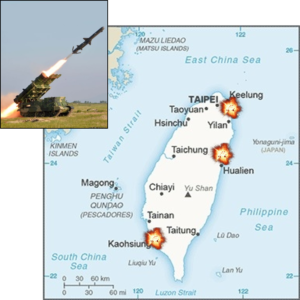 irregular conflicts. The initial stages of a large-scale conflict in the Indo-Pacific could involve limited indications and warnings, an adversary capable of leveraging time, space, distance, and the ability to converge effects across multiple domains, and a saturated and fragmented global information fight. VEOs also now have access to more lethal capabilities that may enable them to exert temporary advantages over a more capable nation’s military. The democratization of cyber, EW, and information capabilities allow increasing numbers of actors to create effects in multiple domains and amplify the impact of kinetic actions. Information’s ubiquity in the national and international spaces also expands the battlefield, enabling increased participation from outside actors and broadening the international audiences whose perceptions may be critical in the information fight. As the Israel-HAMAS war continues to develop, observations regarding changes or continuity in irregular wars will gain fidelity. It already seems clear, however, that VEOs are working to refine their capabilities just as regular militaries are, and recent large-scale conflicts have provided ample lessons for leveraging changes in the Operational Environment to their advantage.
irregular conflicts. The initial stages of a large-scale conflict in the Indo-Pacific could involve limited indications and warnings, an adversary capable of leveraging time, space, distance, and the ability to converge effects across multiple domains, and a saturated and fragmented global information fight. VEOs also now have access to more lethal capabilities that may enable them to exert temporary advantages over a more capable nation’s military. The democratization of cyber, EW, and information capabilities allow increasing numbers of actors to create effects in multiple domains and amplify the impact of kinetic actions. Information’s ubiquity in the national and international spaces also expands the battlefield, enabling increased participation from outside actors and broadening the international audiences whose perceptions may be critical in the information fight. As the Israel-HAMAS war continues to develop, observations regarding changes or continuity in irregular wars will gain fidelity. It already seems clear, however, that VEOs are working to refine their capabilities just as regular militaries are, and recent large-scale conflicts have provided ample lessons for leveraging changes in the Operational Environment to their advantage.
If you enjoyed this post, check out some of today’s co-authors’ previous blog posts:
Gaming Information Dominance, China’s Economic Ascendency through 2040, and Russia-Ukraine Conflict: Sign Post to the Future (Part 1), by Kate Kilgore
“Once More unto The Breach Dear Friends”: From English Longbows to Azerbaijani Drones, Army Modernization STILL Means More than Materiel, How China Fights and associated podcast, How Russia Fights 2.0 and associated podcast, China and Russia: Achieving Decision Dominance and Information Advantage, and “No Option is Excluded” — Using Wargaming to Envision a Chinese Assault on Taiwan, by Ian Sullivan
… as well as the following related content:
Extremism on the Horizon: The Challenges of VEO Innovation, by Colonel Montgomery Erfourth and Dr. Aaron Bazin
On Surprise Attacks Below the “Bolt from the Blue” Threshold, by Lesley Kucharski
Other People’s Wars: The US Military and the Challenge of Learning from Foreign Conflicts and associated podcast, with Brent L. Sterling
Death From Above! The Evolution of sUAS Technology and associated podcast, with COL Bill Edwards (USA-Ret.)
Unmanned Capabilities in Today’s Battlespace
Insights from the Robotics and Autonomy Series of Virtual Events, as well as all of the associated webinar content (presenter biographies, slide decks, and notes) and associated videos
Insights from Ukraine on the Operational Environment and the Changing Character of Warfare
Top Attack: Lessons Learned from the Second Nagorno-Karabakh War and associated podcast
Insights from the Nagorno-Karabakh Conflict in 2020 (Parts 1 and 2)
Jomini’s Revenge: Mass Strikes Back! by proclaimed Mad Scientist Zachery Tyson Brown
How Big of a Deal are Drone Swarms?, A New Age of Terror: The Future of CBRN Terrorism, and A New Age of Terror: New Mass Casualty Terrorism Threats, by proclaimed Mad Scientist Zachary Kallenborn
The Convergence: The Future of Ground Warfare and associated podcast, with COL Scott Shaw
The Dawn of the Loitering Munitions Era, by proclaimed Mad Scientist SGM Daniel S. Nasereddine
Weaponized Information: What We’ve Learned So Far…, Insights from the Mad Scientist Weaponized Information Series of Virtual Events, and all of this series’ associated content and videos
The Future of War is Cyber, by CPT Casey Igo and CPT Christian Turley
About the Authors:
Ian M. Sullivan is the Deputy Chief of Staff, G-2 for the U.S. Army Training and Doctrine Command (TRADOC). He holds a BA from Canisius University in Buffalo, NY, an MA from Georgetown University’s BMW Center for German and European Studies in Washington, DC, and was a Fulbright Fellow at the Universität Potsdam in Potsdam, Germany. A career civilian intelligence officer, Mr. Sullivan has served with the Office of Naval Intelligence, Headquarters U.S. Army Europe and Seventh Army, the Office of the Director of National Intelligence’s (ODNI) National Counterterrorism Center, the Central Intelligence Agency, and at TRADOC. He is a member of the Defense Intelligence Senior Executive Service and was first promoted to the senior civilian ranks in 2013 as a member of the ODNI’s Senior National Intelligence Service.
Kate Kilgore is a U.S. Army TRADOC G2 analyst. Her work to build the Army’s understanding of the threat spans topics including Homeland Defense, Large-Scale Combat Operations, and the developing Operational Environment. Kate has also supported Army-level tabletop exercises at USARPAC and USARNORTH as a member of the TRADOC G2 Red Cell. Kate graduated with a bachelor’s degree from Indiana University, where she studied Law, International Politics, and Soviet Studies. She grew up in an Army family and has lived all over the United States and Germany.
Disclaimer: The views expressed in this blog post do not necessarily reflect those of the U.S. Department of Defense, Department of the Army, Army Futures Command (AFC), or Training and Doctrine Command (TRADOC).
[i] https://www.economist.com/middle-east-and-africa/2023/10/09/hamass-attack-was-an-israeli-intelligence-failure-on-multiple-fronts
[ii] https://www.economist.com/middle-east-and-africa/2023/10/09/hamass-attack-was-an-israeli-intelligence-failure-on-multiple-fronts
[iii] https://www.reuters.com/world/middle-east/how-israel-was-duped-hamas-planned-devastating-assault-2023-10-08/
[iv] https://www.bbc.com/news/world-middle-east-67056987
[v] https://www.businessinsider.com/hamas-drones-take-out-comms-towers-ambush-israel-2023-10
[vi] https://www.forbes.com/sites/davidhambling/2023/10/09/how-hamas-leveraged-cheap-rockets-and-small-drones-to-ambush-israel/?sh=7c03dd0d6be2
[vii] https://abcnews.go.com/Politics/israels-iron-dome-air-defense-system-overwhelmed/story?id=103872036
[viii] https://abcnews.go.com/Politics/israels-iron-dome-air-defense-system-overwhelmed/story?id=103872036
[ix] https://www.forbes.com/sites/davidhambling/2023/10/09/how-hamas-leveraged-cheap-rockets-and-small-drones-to-ambush-israel/?sh=7c03dd0d6be2
[x] https://www.understandingwar.org/backgrounder/iran-update-october-15-2023
[xi] https://www.msn.com/en-us/news/world/pro-hamas-hackers-send-fake-rocket-alerts-knock-websites-offline/ar-AA1hWGFe
[xii] https://www.axios.com/2023/10/10/hackers-ddos-israel-hamas-conflict
[xiii] https://www.msn.com/en-us/news/world/pro-hamas-hackers-send-fake-rocket-alerts-knock-websites-offline/ar-AA1hWGFe
[xiv] https://www.reuters.com/world/middle-east/how-israel-was-duped-hamas-planned-devastating-assault-2023-10-08/
[xv] https://time.com/6322175/israel-hamas-cyberattacks-hackers/
[xvi] https://www.businessinsider.com/hamas-drones-take-out-comms-towers-ambush-israel-2023-10
[xvii] https://www.nytimes.com/2023/10/10/opinion/israel-hamas-.html
[xviii] https://www.reuters.com/world/middle-east/israels-reservists-drop-everything-rush-home-following-hamas-bloodshed-2023-10-12/
[xix] https://www.cnn.com/2023/10/11/middleeast/maps-population-density-gaza-israel-dg/index.html
[xx] https://www.cnn.com/2023/10/13/middleeast/israel-gaza-hamas-war-friday-intl-hnk/index.html
[xxi] More than the U.S. combined reserve force
[xxii] https://www.reuters.com/world/middle-east/israels-reservists-drop-everything-rush-home-following-hamas-bloodshed-2023-10-12/
[xxiii] https://www.bellingcat.com/news/2023/10/11/hamas-attacks-israel-bombs-gaza-and-misinformation-surges-online/
[xxiv] https://www.vox.com/technology/2023/10/12/23913472/misinformation-israel-hamas-war-social-media-literacy-palestine
[xxv] https://www.bellingcat.com/news/2023/10/11/hamas-attacks-israel-bombs-gaza-and-misinformation-surges-online/
[xxvi] https://apnews.com/article/social-media-gaza-israel-hamas-misinformation-cb5192215d0f89d8a413606d0ec73cf4
[xxvii] https://www.theguardian.com/technology/2023/oct/13/instagram-threads-misinformation-israel-hamas
[xxviii] https://www.cnn.com/2023/10/13/middleeast/israel-gaza-hamas-war-friday-intl-hnk/index.html
[xxix] https://www.aljazeera.com/features/2023/10/11/analysis-why-did-hamas-attack-now-and-what-is-next
[xxx] https://www.foreignaffairs.com/israel/second-front-hamas-war-hezbollah-turmoil
[xxxi] https://www.washingtonpost.com/national-security/2023/10/09/iran-support-hamas-training-weapons-israel/#:~:text=The%20Palestinian%20militants%20behind%20the,Western%20and%20Middle%20Eastern%20intelligence
[xxxii] https://www.cnn.com/2023/10/13/middleeast/israel-gaza-hamas-war-friday-intl-hnk/index.html
[xxxiii] https://www.cbsnews.com/news/why-did-hamas-attack-israel-and-why-now/
[xxxiv] https://www.newsweek.com/iran-israel-hamas-multi-front-conflict-1833381

